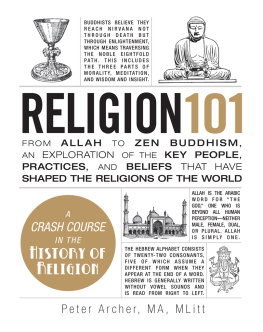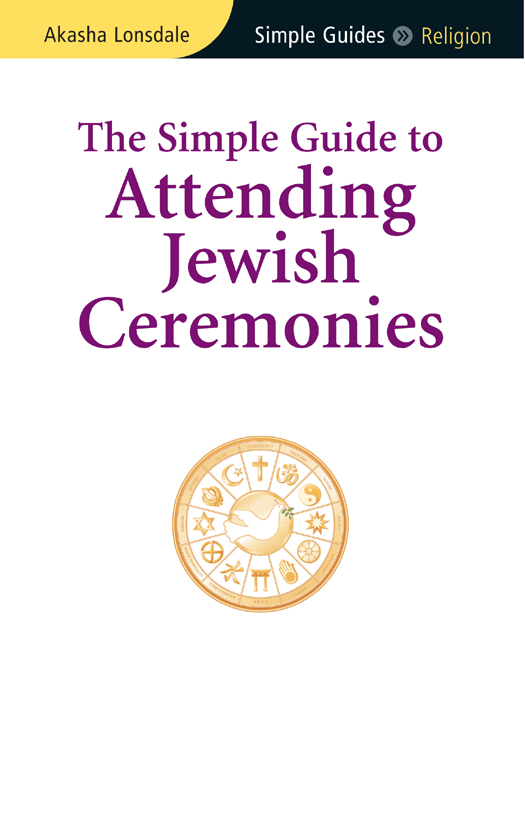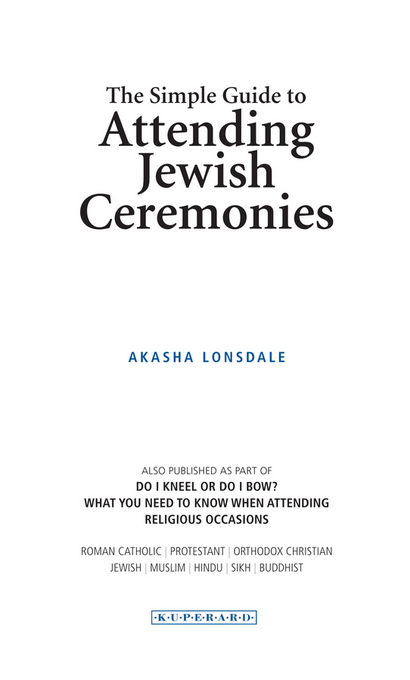Published in Great Britain by
Kuperard, an imprint of Bravo Ltd
59 Hutton Grove, London N12 8DS
www.kuperard.co.uk
Enquiries:
Copyright 2011 Kuperard
All rights reserved. No part of this publication may be reproduced, stored in a retrieval system, or transmitted in any form or by any means without prior permission in writing from the Publishers.
Series Editor Geoffrey Chesler
eISBN: 978-1-85733-648-1
British Library Cataloguing in Publication Data
A CIP catalogue entry for this book
is available from the British Library.
This e-book first featured as part of the multi-faith volume Do I Kneel or Do I Bow? What You Need to Know When Attending Religious Occasions www.kuperard.co.uk/cgi-bin/articles.pl?id=1732§ion=110&action=display (ISBN 978 1 85733 524 8). It describes and explains religious ceremonies that you may be invited to attend, and offers advice on how to behave, so that you dont inadvertently give offence or cause embarrassment to yourself or others. Because of the variety of traditions, customs and cultural influences within each religion, you may experience some differences from what is described here, but the basic forms and features of the ceremonies will be the same. Other titles are:
The Simple Guide to Attending Christian Ceremonies (eISBN 978 1 85733 646 7)
The Simple Guide to Attending Orthodox Christian Ceremonies (eISBN 978 1 85733 647 4)
The Simple Guide to Attending Muslim Ceremonies (eISBN 978 1 85733 649 8)
The Simple Guide to Attending Hindu Ceremonies (eISBN 978 1 85733 651 1)
The Simple Guide to Attending Sikh Ceremonies (eISBN 978 1 85733 652 8)
The Simple Guide to Attending Buddhist Ceremonies (eISBN 978 1 85733 653 5)
Photo on Akasha Lonsdale
The photo on is reproduced by permission of Hilah and Eitan Rubin-Razinsky.
Images on
Images on the following pages are reproduced under Creative Commons Attribution ShareAlike Licenses 1.0, 2.0, 2.5 and 3: Aviv Hod.
v3.1
ABOUT THE AUTHOR
AKASHA LONSDALE is an Interfaith Minister whose vocation brings her into frequent contact with with people of every faith and none. Her two-year seminary training in London included instruction in the major religions and sacred traditions of the world.
She has practised as a psychotherapist, both privately and within Britains National Health Service. Her corporate background was in senior human resource management. She is an executive coach, trainer, seminar speaker and frequent contributor to the media on topical issues. Specialising in Emotional Intelligence and Stress Management, she has written for a variety of publications, and her book How to Do Life Powerful Pointers for Powerful Living is a popular self-help title in the United Kingdom.
Akasha Lonsdale brings to The Simple Guide to Attending Jewish Ceremonies an informed, sympathetic and practical approach born of wide knowledge, personal experience and psychological insight.
CONTENTS
WHAT JEWS BELIEVE
Judaism is a monotheistic religion, believing in one Supreme Being a merciful, just, all-seeing, all-knowing and all-powerful God who created and rules the world. It introduced a personal moral code and also the idea of free will, responsibility for choices made and individual accountability. The aim of Judaism is to sanctify life through education, prayer and observance of the ethical and ritual precepts of the Torah. By these acts Jews become partners with God in fulfilling His purpose.
Defined by their beliefs and actions, the Jewish people evolved from the biblical Canaanites and Israelites. In time Jewish communities grew up outside the land of Israel. The destruction of the Jewish Temple in Jerusalem by Rome in 70 CE had two major consequences: it reinforced this dispersal, known as the Diaspora (Greek, scattered seeds), so that the majority of Jews came to live outside historical Israel, and it gave rise to the system of law and custom still recognizable in modern Judaism. Jewish people, wherever they are, share the ceremonies, rituals, laws and commandments of their faith.
Jews do not believe that Jesus was the prophesied Messiah who would usher in an age of peace. This, it is believed, will only happen when the true Messiah from the house of David finally comes.
SACRED WRITINGS
The Jewish holy book is the Tanakh, an acronym for three sets of ancient Hebrew texts Torah, Neviim and Ketuvim. Known as the Written Law, these texts contain Gods instructions for living a good and spiritual life. The Torah consists of the Five Books of Moses (Genesis to Deuteronomy in the Old Testament of the Christian Bible) given to the Jewish people at Mount Sinai during their exodus from Egypt. It contains 613 mitzvot (commandments) whose purpose is the sanctification of creation including the Ten Commandments, given to Moses on two stone tablets. Neviim (the Book of Prophets) contains direct prophecies from God, and Ketuvim (Writings) records the wisdom of David and Solomon and includes the Books of Esther and Ruth.
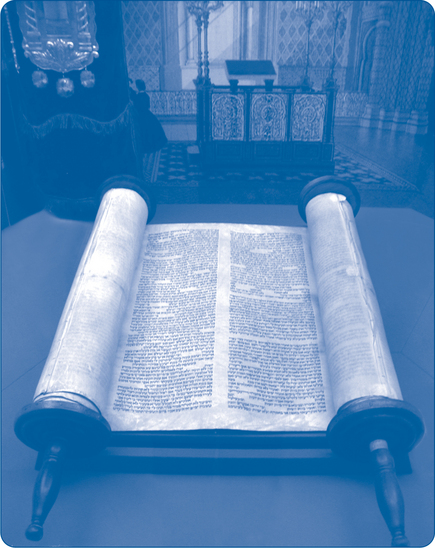
A Sefer Torah unrolled for reading in the former Glockengasse synagogue in Cologne.
Parallel to the Written Law was the Oral Law, the oral tradition passed down through the generations until after the destruction of the Temple, when it was compiled, edited and written down. This compilation is called the Mishnah, and the various questions, discussions and decisions that arose from it are contained within a long Aramaic commentary called the Talmud (Hebrew, study), also known by the Aramaic name Gemara. These relate to the Halakhah (Hebrew, way or path) Jewish law determining ritual practice and ethical behaviour.
THE NAMES OF GOD
God is called by many different names in the Bible. The Hebrew four-letter name of God YHVH, revealed to Moses at the Burning Bush is so sacred that it is never spoken by Jews. This name is used in the Torah when referring to Gods relationship to the people of Israel, and by Jewish scholars when describing His attribute of mercy. The other most commonly found name of God is Elohim. This is used when describing Gods relationship to the world generally, and according to scholars refers to His attribute of justice. Another frequently used name is Adonai (my Lord), and there are very many other, essentially descriptive, names for God. However, in conversation some religious Jews will refer to God as Ha-shem (the Name) in Hebrew, and in English will write it as G-d.
BRANCHES OF JUDAISM
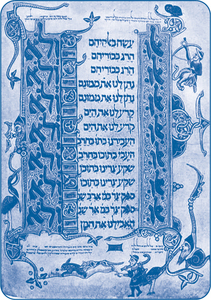
Illuminated medieval Haggadah, the text read at the Passover supper.
Like many religions, Judaism has different traditions, branches and sects. The main historical division is between Sephardim and Ashkenazim Jews originating in medieval Spain and Germany respectively. Although the two groups differ in their culture, customs, pronunciation of Hebrew and liturgical practices, there are no doctrinal differences.


